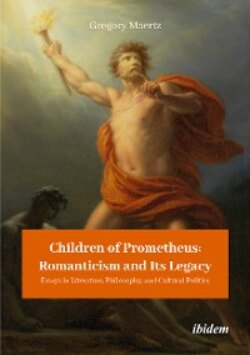Children of Prometheus: Romanticism and Its Legacy

Реклама. ООО «ЛитРес», ИНН: 7719571260.
Оглавление
Gregory Maertz. Children of Prometheus: Romanticism and Its Legacy
Preface and Acknowledgements
1 The Paradoxes of Faith in Sir Thomas Browne and Kierkegaard
2 Intertextual Dialogue: Father and Daughter Novelists
II
III
3 Tolstoy and the “Spiritual Delights” of Schopenhauer
4 Rilke’s Self-Portrait and the Example of Rodin
5 Three Modernist Poets and the Search for Cultural Rebirth
6 William Godwin: A Life in Literature and Politics
7 German Literature and English Radicalism
William Taylor of Norwich
8 Generic Fusion in the Romantic Travel Novel
9 From Translation to Authorship: Anglophone Women Writers and Goethe
Mary Wollstonecraft
Sarah Austin and Margaret Fuller
George Eliot
Отрывок из книги
ibidem-Press, Stuttgart
Wanda Irene Lani Len Parker
.....
With the appropriation and rewriting of St. Leon Mary attains independence, as a creator of texts, from both her father and her husband. For her husband, she serves as an extension of her father; her elopement and marriage to Shelley represent efforts on his part to attain consanguinity with her father, his great idol, through the instrumentality of her mind and body. At the same time, it reflects Percy’s attempt to usurp Godwin’s role as Mary’s primary educator and literary precursor. We can see this as an attempted exclusionary gesture whose objective is to assume control over her continuing development as a writer. In Frankenstein Mary therefore seeks to perform a double divestiture not only of parental influence, but also of authoritative discourse associated with both dominating literary figures in her life, her father and her husband. In this way the novel serves as a powerful reminder that literary texts function instrumentally. In Holquist’s phrase, “they serve as a prosthesis of the mind. As such, they have a tutoring capacity that materially effects change by getting from one stage of development to another,” and in its dual capacity as an enabling device and as a necessary stage in the dialectic of education leading to the attainment of a secure authorial identity, Frankenstein enacts for its author and protagonists a dual process of soul and voice formation.31 Emulating Reginald’s and Victor’s search for ideal companionship, empowering knowledge and opportunities for doing some action that is “great and good,” the Monster’s odyssey begins with the discovery that he lives in a hostile world and that he has been rejected by his “father” and denied the right to engender his own offspring. His odyssey or Bildungsreise ends with the murderous inversion of Godwinian altruism as he lashes out at Victor, destroying all those with whom he enjoys emotional intimacy in order to render his condition identical to his own. The rebellion of the Monster, which proceeds from inarticulate rage to the discovery of speech and the art of discourse, invites comparisons with Mary’s efforts, first, to assimilate and, secondly, to overcome her father’s authoritative discourse, a process which culminates in her marriage to Shelley and the nearly simultaneous inception of her novel.
Recognizing that even the most persuasive interpretation may fail to convince, I would hesitate to suggest that the genesis and development of Mary’s novel is fully explained as the result of intertextual dialogue with Godwin’s St. Leon. Neither would I reduce the text’s function to mapping her development as a writer. But, as I have attempted to show, such an interpretation brings us closer to the novel’s textual and psychological matrices and it delineates the central autotherapeutic function of writing. Moreover, by adopting Bakhtin’s dialogic framework we gain a more pronounced awareness of the struggle involved in moving beyond mere appropriation of another’s authoritative discourse to the production of discourse that is distinctly one’s own. In contrast to those critics who have inserted Frankenstein into or extracted the novel from a patriarchal tradition, the preceding discussion should make it is possible to reject both alternatives. The tradition into which we should place Frankenstein is that which makes apparent its structure and language as empowering psychological scaffolding. Godwin’s St. Leon provided Mary with a dialogic partner in the struggle for self-expression, and Frankenstein is a reflection of the will to articulate her own consciousness and to attain individuation apart from the discourse associated with the “strong precursors” in her personal and literary experience. What makes the intertextual dialogue forming Frankenstein of particular interest is that the authoritative discourse with which its young author contended was formed by the texts of her father, mother, and husband—a body of texts that she habitually and even ritually read at home and on her mother’s grave in the St. Pancras churchyard. This is the tradition formed by St. Leon. From this perspective Mary’s novel can be seen to replicate intertextual dialogue with a text that we can readily identify, St. Leon, and because of Shelley’s filial relationship with its author, it is possible to extrapolate from this process of intertextual dialogue to her development and growth as a writer. The end result of this process is the acquisition and exercise of genuine cultural power.
.....